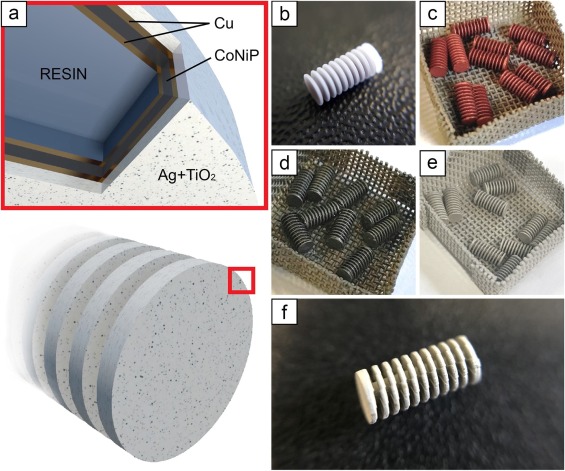
Internal structure of the photoactive/antimicrobial devices (a); device appearance after 3D printing (b); devices placed in the barrel setup after electroless Cu deposition (c); devices after CoNiP deposition (d); devices after Ag/TiO2 plating (e); final microrobots appearance (f).
Better processes are necessary for bringing clean water to the world, and researchers from both Switzerland and Italy detail the advantages of progressive cleaning devices in ‘Magnetically navigable 3D printed multifunctional microdevices for environmental applications.’
While most of us take water for granted—and even waste plenty of it daily just brushing teeth or washing dishes without much thought—it is a commodity, and a dire need in many parts of the world. Thirst plays a major part in that need, but polluted water and bacteria can lead to major illnesses that are deadly to humans, such as cholera and dysentery. Other pollution may be environmental, leading to clusters of cancer in certain areas. Small machines referred to as ‘swimmers’ have been proposed for use in recent years for water cleaning applications, but as the researchers point out, they are often hard to recover once they are put into use.
The authors have created a 3D printed microrobotic prototype capable of finding pollutants and kill bacteria. Ranging from micrometers to millimeters, the small machines can be fabricated affordably and quickly—with batch production easily achieved. Fabricated via SLA 3D printing, the microdevices were created with a magnetic layer (composed of silver) that allows for remote action due to a controlling magnetic field. The microdevices were also coated with a silver/titania composite:

Morphology of the initial electroless Cu layer employed to impart conductivity to the 3D printed surface (a), scale bar is 2 μm; morphology of the CoNiP layer (b), scale bar is 2 μm; structure of a metallized SP sample (c), scale bar is 400 μm; surface morphology of the final Ag/TiO2 composite (d), scale bar is 4 μm; VSM characterization of a PL sample coated with CoNiP (e); AFM characterization of an uncoated (f), Cu/CoNiP coated (g) and Cu/CoNiP/Cu/Ag/TiO2 coated (h) device.
“The biocidal activity of silver and the photocatalytic properties of titania can be combined in a composite material to achieve integrated water cleaning functionalities, as demonstrated in recent literature in the case of chemical vapor deposited layers,” stated the authors. “In order to combine silver and titania in the same platform, however, electrochemical codeposition is the most attractive method as it allows the easy and cost-effective growth of dispersion coatings made of metallic matrices with embedded ceramic micro- or nanoparticles.”
The technique used for these small devices is called ‘barrel plating,’ allowing for a volume of objects to be put into a container and conduct electricity through contact of the parts and the container. The parts were printed on a commercial stereolithography machine, model 028 J Plus produced by Digital Wax Systems (DWS), with a urethane-acrylate based resin (DL260 by DWS) filled with 20% m/m silica-alumina powder. While the coatings were assessed to be ‘less conformal than their electroless counterparts,’ the researchers found them suitable for water cleaning, with photocatalytic and antimicrobial activity.
“The microrobots obtained in the present work may find application in the water purification inside small water reservoirs and canalizations, possibly with a scaled up magnetic actuation setup,” concluded the researchers. “Moreover, the devices can be used for bacteria control also in presence of mammal cells. This fact suggests a possible use also in-vivo inside human body. In conclusion, they are attractive for applications requiring a combination of antimicrobial and photocatalytic functionalities that must be carried out, also separately, in a highly localized and precise way.”
As 3D printing affects nearly every type of field imaginable, the water industry is no exception—and the results have been able to make a true difference not only in research and development for better systems, but also in actual processes today. Improvements in parts have been made in the case of water treatment materials like membranes, devices for measuring water quality, and even strides in increasing access to clean water overall. What do you think of this news? Let us know your thoughts! Join the discussion of this and other 3D printing topics at 3DPrintBoard.com.
[Source / Images: Magnetically navigable 3D printed multifunctional microdevices for environmental applications]Subscribe to Our Email Newsletter
Stay up-to-date on all the latest news from the 3D printing industry and receive information and offers from third party vendors.
You May Also Like
Profiling a Construction 3D Printing Pioneer: US Army Corps of Engineers’ Megan Kreiger
The world of construction 3D printing is still so new that the true experts can probably be counted on two hands. Among them is Megan Kreiger, Portfolio Manager of Additive...
US Army Corps of Engineers Taps Lincoln Electric & Eaton for Largest 3D Printed US Civil Works Part
The Soo Locks sit on the US-Canadian border, enabling maritime travel between Lake Superior and Lake Huron, from which ships can reach the rest of the Great Lakes. Crafts carrying...
Construction 3D Printing CEO Reflects on Being Female in Construction
Natalie Wadley, CEO of ChangeMaker3D, could hear the words of her daughter sitting next to her resounding in her head. “Mum, MUM, you’ve won!” Wadley had just won the prestigious...
1Print to Commercialize 3D Printed Coastal Resilience Solutions
1Print, a company that specializes in deploying additive construction (AC) for infrastructure projects, has entered an agreement with the University of Miami (UM) to accelerate commercialization of the SEAHIVE shoreline...






























